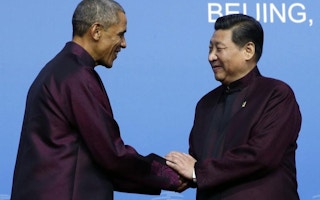The United States and China unveiled ambitious targets Wednesday to reduce greenhouse gases, aiming to inject fresh momentum into the global fight against climate change ahead of a make-or-break treaty to be finalized next year.
President Barack Obama announced that the US would move much faster in cutting pollution, with a goal to reduce by 26 per cent to 28 per cent by 2025, compared with 2005 levels. Earlier in his presidency, Obama set a goal to cut emissions by 17 per cent by 2020.
Chinese President Xi Jinping, whose country’s emissions are still growing as it builds new coal plants, didn’t commit to cut emissions by a specific amount. Rather, he set a target for China’s emission to peak by 2030, or earlier if possible. He also pledged to increase the share of energy that China will derive from sources other than fossil fuels such as solar power and windmills.
“
It sends the signal the two largest emitters in the world are working together to address this problem
David Sandalow, formerly a top environmental official at the White House and the Energy Department
Both leaders were attending the Asia-Pacific Economic Cooperation (APEC) summit, hosted this year by Beijing.
The breakthrough by the world’s two largest polluters reflected the nations’ desire to display a united front on climate change, blunting arguments from developing countries that have balked at demands that they get serious about cutting emissions. The inequality of climate change is that rich nations developed using polluting resources while poor nations are hard-hit by environmental changes such as rising sea levels.
Environmental advocates have long held that without agreement between the top carbon polluters, few other countries would cut emissions.
Yet it was unclear how feasible it would be for either country to meet their goals, and Obama’s pledge was sure to confront tough opposition from ascendant Republicans in Congress.
In an op-ed in the New York Times, Secretary of State John Kerry said the “milestone” was the result of an “effort that began last year in Beijing, when State Councilor Yang Jiechi and I started the United States-China Climate Change Working Group. It was an effort inspired not just by our shared concern about the impact of climate change, but by our belief that the world’s largest economies, energy consumers, and carbon emitters have a responsibility to lead.”
David Sandalow, formerly a top environmental official at the White House and the Energy Department, said, “This is, in my view, the most important bilateral climate announcement ever. … It sends the signal the two largest emitters in the world are working together to address this problem.”
Obama’s target, expected to serve as the US contribution to a worldwide treaty to be finalized next year in Paris, came months before it had been expected. The US has sought to show aggressive action on climate change in order to spur other nations to offer ambitious contributions, too.
In June, the Obama administration announced plans to cut harmful emissions at existing power plants by 30 per cent on 2005 figures, a significant move against climate change. The new rule on carbon dioxide emissions, which is set to finalized next year after an extended comment period, is intended to form the centerpiece of Obama’s plans to reduce pollution linked to global warming.
For China, the commitment to cap emissions marked a turning point in China’s evolution on global warming and its responsibility to deal with the problem. China accounts for around 30 per cent of global emissions, but has only gotten serious in recent years as the large-scale impact on health and quality of life in China has come into focus, exacerbated by smothering smog in Beijing’s skies.
Earlier this year Chinese Premier Li Keqiang said he was “declaring war” on pollution, describing it as a “red-light warning” against inefficiency as he addressed widespread and very public complaints about pollution, a topic that has drawn much negative international attention when air pollution forced schools to close and grounded flights. He referred to the fouling of the country’s air, water and soil as “nature’s red-light warning against the model of inefficient and blind development.”
“We will declare war against pollution and fight it with the same determination we battled poverty,” he said.
But Chinese authorities have repeatedly pledged action to improve the environment in recent months, and experts warn that implementation will be key.
Environmental advocates in the US heralded the joint announcements as a game-changer that would undermine opposition. If China can get serious about emissions, they said, surely others can, too.
“Now there is no longer an excuse for Congress to block action,” said Sen. Barbara Boxer, D-Calif, who chairs the Senate’s environmental panel.
But Republicans signaled that they would seek to thwart Obama’s efforts once the GOP controls the Senate next year, pointing out that Obama was saddling future presidents with a tough-to-meet goal.
“This unrealistic plan, that the president would dump on his successor, would ensure higher utility rates and far fewer jobs,” said incoming Senate Majority Leader Mitch McConnell, R-Ky.










